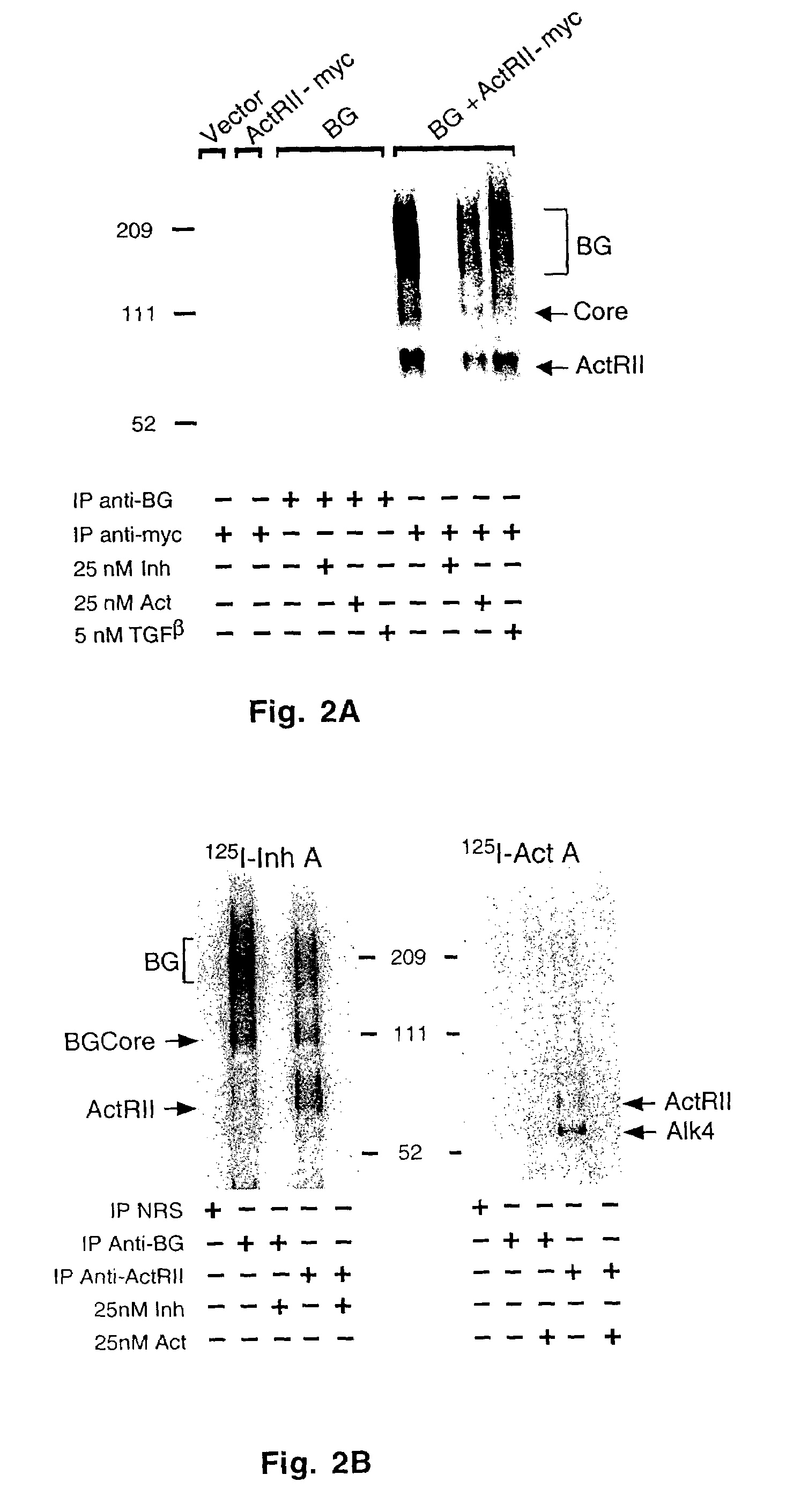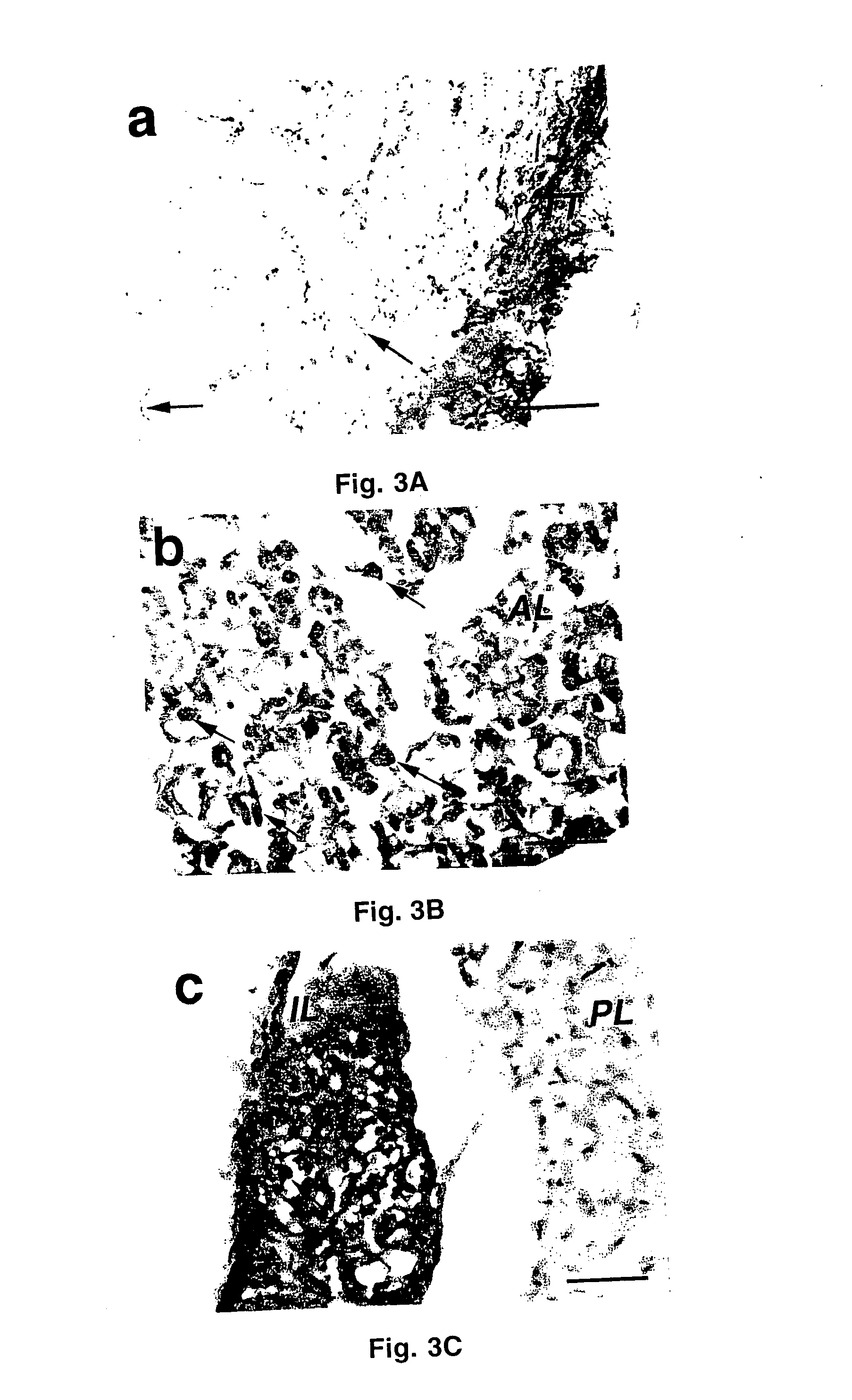Method of inhibiting the formation of inhibin/betaglycan complexes with an anti-betaglycan antibody
- Summary
- Abstract
- Description
- Claims
- Application Information
AI Technical Summary
Benefits of technology
Problems solved by technology
Method used
Image
Examples
example 1
Competition Binding Studies
[0073]Recombinant human activin A and inhibin A were generated using a stable activin-expressing cell line provided by Dr. J. Mather (Genentech, Inc.) and were purified by Wolfgang Fischer (PBL, Salk Institute). [125I]-Activin A and [125I]-Inhibin A were prepared using the chloramine T method as previously described (37).
[0074]For binding studies, cells were transiently transfected using DEAE Dextran with 10 μg of ActRII and / or 10 μg of betaglycan plasmid DNA. The cells were incubated with the DNA for 4 hours, shocked with 10% DMSO in Hepes Dissociation Buffer (HDB), and incubated at 37° C. and 5% CO2 for 48 hours in DMEM containing 10% fetal calf serum and L-glutamine. Confluent monolayers were washed twice with Hepes Dissociation Buffer and resuspended in binding buffer (Hepes Dissociation Buffer with 0.1% BSA, 5 mM MgSO4 and 1.8 mM CaCl2). Binding was carried out by incubating ˜2×105 cells with 2×105 cpm [125I]-inhibin A (approximately 100 pM) for 90 mi...
example 2
Crosslinking Studies
[0075]Crosslinking studies were carried out in cells grown to ˜40-60% confluence in 5% CO2 in complete DMEM (with 10% bovine calf serum, penicillin, streptomycin and L-glutamine). The cells were grown in 10 cm culture dishes and then transfected using the calcium phosphate precipitation method using Hepes-buffered saline (pH 7.07). Following transfection, cells were incubated at 5% CO2 for 48 hours. Cell were harvested by rinsing each plate once with Hepes Dissociation Buffer and then incubating each plate in Hepes Dissociation Buffer containing 1 mM EDTA for 10 min to release the cells.
[0076]Covalent crosslinking was carried out by incubating ˜106 cells resuspended in Hepes Dissociation Buffer with ˜2×106 cpm [125I]-activin A in a total of 500 μl for 1 hour at room temperature with gentle rocking. Following this incubation, 1 ml cold Hepes Dissociation Buffer was added to each tube and cells were then pelleted by centrifugation, resuspended in 500 μl HDB, brough...
example 3
Luciferase Assays in AtT20 and KK-1 Cells
[0077]The function of betaglycan was evaluated in transient transfection experiments using a well-characterized activin / TGF-β-responsive luciferase reporter plasmid, 3TPLux (14). Two mouse cell lines were tested; AtT20 corticotropic cells (grown in DMEM, 10% FBS, 2 mM L-glutamine and gentamycin) and KK-1 ovarian cells (grown in DMEM:F12 with 10% FBS, L-glutamine, penicillin and streptomycin). The cells were trypsinized and plated at a density of 1.5-2×105 cells / well in 6-well plates 24 hours before transfection. The cells were transfected in complete medium with approximately 1 μg of 3TPLux, 0.1-0.2 μg cytomegalovirus (CMV)-β-galactosidase (β-GAL) and 0.1-0.3 μg of either vector or betaglycan plasmid DNA. Transfections were under optimized conditions using the commercially available Superfect Transfection Reagent (Qiagen; Hilden, Germany). After an incubation period of 2.5 h, the cells were washed with medium containing 2% FBS and allowed to ...
PUM
| Property | Measurement | Unit |
|---|---|---|
| Responsivity | aaaaa | aaaaa |
Abstract
Description
Claims
Application Information
 Login to View More
Login to View More - R&D
- Intellectual Property
- Life Sciences
- Materials
- Tech Scout
- Unparalleled Data Quality
- Higher Quality Content
- 60% Fewer Hallucinations
Browse by: Latest US Patents, China's latest patents, Technical Efficacy Thesaurus, Application Domain, Technology Topic, Popular Technical Reports.
© 2025 PatSnap. All rights reserved.Legal|Privacy policy|Modern Slavery Act Transparency Statement|Sitemap|About US| Contact US: help@patsnap.com



